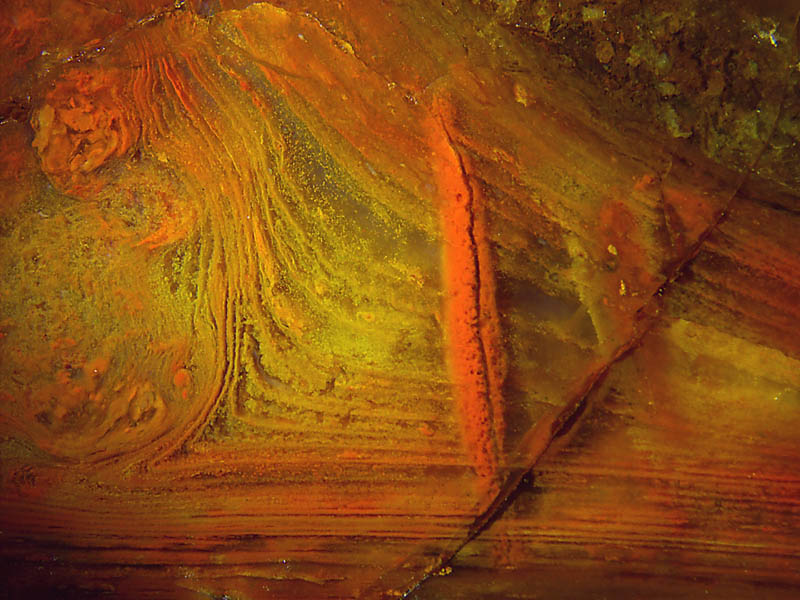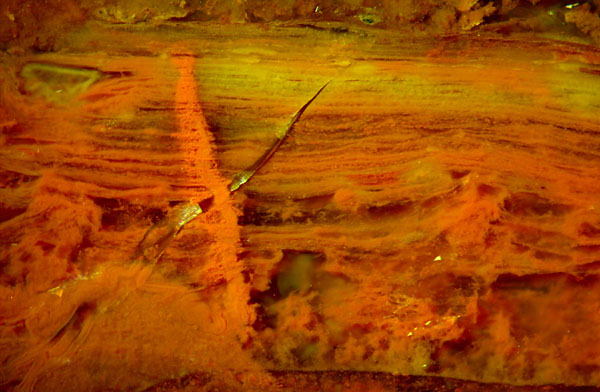Real and
illusory cracks in red Permian chert
These cut faces of chert samples
from Doehlen basin, Germany, are meant to draw attention to the
unexplained formation of "illusory cracks".

Fig.1:
Fossiliferous Permian chert with a deformed stack of sheets of
assumedly microbial origin:
silicified, cracked, healed, stained.
Image width 11mm.
The background of the
scene in Fig.1 is provided by a large stack of sheets
of assumedly microbial
origin:
grown in water, originally nearly plane as seen below, then largely
deformed by some plant part growing inside the
stack on the left, then silicified into hard chalcedony, which broke
and formed a long nearly
straight crack at about 45° irrespective of the
stack texture, indicating that the silicified matter had
become hard and mechanically isotropic.
The gap of the crack had been so narrow that the
sheets had not been
displaced by the crack. It is seen as a pale line in
the dark patches and as a dark line between.
Another crack in Fig.1 apparently had been able to
somehow attract dissolved iron and cause it
to precipitate alongside as a streak of bright
red hematite, a rare phenomenon in
these cherts. Less rare are red streaks
as in Figs.2,3, called here "illusory cracks" for short.
Fig.2: Stack of
assumedly microbial sheets, silicified into brittle Permian chert,
cracked, healed with quartz fill;
"illusory crack" made of red stain traversing
both sheet stack and real crack. Image width 3.5mm.

As seen in Fig.2, the red
streak is a late formation since it traverses structures which
doubtless existed before: sheet stack and real crack. (The brittle
quartz fill of the latter had broken and partially fallen out after
cutting.)
The red streak is
certainly not a former wide crack filled later since careful inspection
shows that it did not interrupt
the thin sheets. One might suspect that a real
crack, very narrow and
unseen here, could be hidden in the red streak. This cannot
be excluded with certainty but
is much less probable in view
of similar red shapes in other chert samples, curved such that an
interpretation as unseen cracks inside seems impossible.
The enigmatic
red streaks in Fig.3 ("illusory
cracks"), mostly sections
of odd-shaped 3D- structures, had grown inside
the stack of
sheets, nearly unaffected by the apparent texture of the stack.
Fig.3 (below): Fancy
structure of enigmatic origin, grown inside
a silicified stack of sheets in Permian chert. Image width
8mm.
 The
"illusory cracks" in Fig.3
seem to have grown in aimless ways through the solid chert but
did not leave the stack. Real cracks
in Figs.2,3, too, kept within the stack as they grew when the stack was
solid but the vicinity was still viscous.
The
"illusory cracks" in Fig.3
seem to have grown in aimless ways through the solid chert but
did not leave the stack. Real cracks
in Figs.2,3, too, kept within the stack as they grew when the stack was
solid but the vicinity was still viscous.
More
examples of wondrous red structures, probably formed last in
solid siliceous matter, are presented in Permian Chert News 18, 27,
28,
36,
37,
38.
The thin
sheets in the stacks have been assumed to be of microbial origin
although the very microbes have not been seen in these cherts. Occasionally
visible tiny granular or cell-like structures could possibly be some
kind of pseudocells
formed by microbes.
The red formations unrelated to
fossil structures must have resulted from diffusional transport of
dissolved iron with subsequent oxidation and
precipitation as hematite, combined with the yet to be found reason behind the awkward shapes with often distinct boundaries.
Figs.1,2,3: Samples H/333.2, H/375.1, H3/102 found
in 2001 at Hänichen, Doehlen basin, Saxony.
H.-J. Weiss 2022
 |
 41 41 |

 41
41

 The
"illusory cracks" in Fig.3
seem to have grown in aimless ways through the solid chert but
did not leave the stack. Real cracks
in Figs.2,3, too, kept within the stack as they grew when the stack was
solid but the vicinity was still viscous.
The
"illusory cracks" in Fig.3
seem to have grown in aimless ways through the solid chert but
did not leave the stack. Real cracks
in Figs.2,3, too, kept within the stack as they grew when the stack was
solid but the vicinity was still viscous. 
 41
41